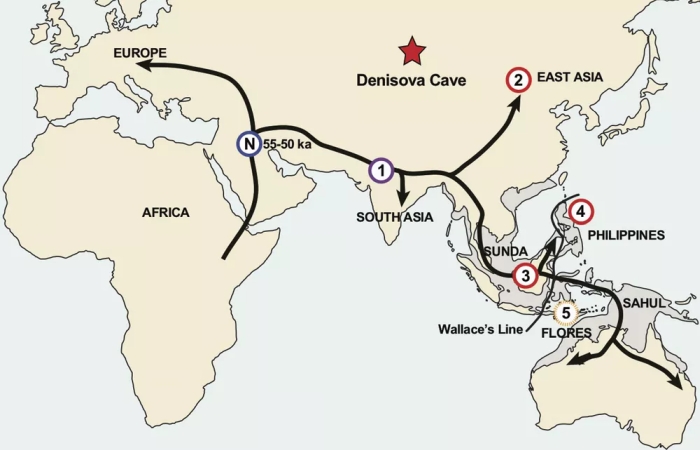The alchemist
VIP
"When modern humans started emerging from Africa and spreading throughout Eurasia, they found many places already occupied by older hominids such as Neanderthals and Denisovans. As humans do, we got rather friendly with our new neighbours: evidence of that hanky panky lives on in our DNA today.
But we're also starting to find glimpses of something strange in our neighbourhoods - traces of ancient, unknown hominids that we've never seen before.
"Each of us carry within ourselves the genetic traces of these past mixing events," said biologist João Teixeira of the University of Adelaide.
"These archaic groups were widespread and genetically diverse, and they survive in each of us. Their story is an integral part of how we came to be."
After closely analysing the existing literature, Teixeira and his colleague biologist Alan Cooper have identified two such 'ghost' ancestors in modern DNA. The first, identified in Eurasian DNA with the help of artificial intelligence, was widely reported earlier this year.
The second, however, was reported last year, a detail that flew under the radar in a larger paper: a mysterious, and inconclusive, genetic signature exclusively found in the population of Flores, Indonesia. It appears to be as divergent from modern human DNA as Neanderthal or Denisovan DNA is.
By carefully analysing these genetic signatures, the biologists have been able to trace when and where these interbreeding events may have occurred.
"For example, all present-day populations show about 2 percent of Neanderthal ancestry," Teixeira said, "which means that Neanderthal mixing with the ancestors of modern humans occurred soon after they left Africa, probably around 50,000 to 55,000 years ago somewhere in the Middle East."
As the modern humans moved farther east, across into islands of Southeast Asia, they seem to have run into more groups.
"At least three other archaic human groups appear to have occupied the area, and the ancestors of modern humans mixed with them before the archaic humans became extinct," Teixeira said.
One of those groups was the Denisovans. The other two remain a mystery.
The first unknown extinct hominid - named EH1 - was roughly genetically equidistant from Denisovans and Neanderthals. The ancestor of all Asian and Australo-Papuan populations bred with EH1, resulting in 2.6 to 3.4 percent shared EH1 ancestry.

It's less strong now, but that genetic signal can still be detected in the DNA of Aboriginal Australians, East Asians and Andaman Islanders. This led the researchers to tentatively conclude that EH1 likely occupied a region in northern India, where a group of modern humans - the migration branch that went on to Asia, Australia and the Papuan islands - encountered them (1 on the map above).
Modern humans also seemed to have interbred with Denisovans in a number of locations, such as East Asia, the Sunda Shelf, and the Philippines (2, 3, and 4 on the map).
Evidence for EH2 - the extinct hominid that interbred with modern humans on Flores - is a little less clear. It only appears in short-statured people that live near Liang Bua Cave - where Homo floriensis was discovered. So it's highly localised, and has somehow remained contained for the roughly 50,000 years since the two groups met (5 on the map).
Further research is obviously required into this phenomenon. But it certainly seems to point to a very tangled human history.
"We knew the story out of Africa wasn't a simple one, but it seems to be far more complex than we have contemplated," Teixeira said.
"The Island Southeast Asia region was clearly occupied by several archaic human groups, probably living in relative isolation from each other for hundreds of thousands of years before the ancestors of modern humans arrived."
Sadly, it also looks like the arrival of modern humans was pretty closely followed by the extinction of the archaic hominids in each area. Talk about being ghosted."
Link
But we're also starting to find glimpses of something strange in our neighbourhoods - traces of ancient, unknown hominids that we've never seen before.
"Each of us carry within ourselves the genetic traces of these past mixing events," said biologist João Teixeira of the University of Adelaide.
"These archaic groups were widespread and genetically diverse, and they survive in each of us. Their story is an integral part of how we came to be."
After closely analysing the existing literature, Teixeira and his colleague biologist Alan Cooper have identified two such 'ghost' ancestors in modern DNA. The first, identified in Eurasian DNA with the help of artificial intelligence, was widely reported earlier this year.
The second, however, was reported last year, a detail that flew under the radar in a larger paper: a mysterious, and inconclusive, genetic signature exclusively found in the population of Flores, Indonesia. It appears to be as divergent from modern human DNA as Neanderthal or Denisovan DNA is.
By carefully analysing these genetic signatures, the biologists have been able to trace when and where these interbreeding events may have occurred.
"For example, all present-day populations show about 2 percent of Neanderthal ancestry," Teixeira said, "which means that Neanderthal mixing with the ancestors of modern humans occurred soon after they left Africa, probably around 50,000 to 55,000 years ago somewhere in the Middle East."
As the modern humans moved farther east, across into islands of Southeast Asia, they seem to have run into more groups.
"At least three other archaic human groups appear to have occupied the area, and the ancestors of modern humans mixed with them before the archaic humans became extinct," Teixeira said.
One of those groups was the Denisovans. The other two remain a mystery.
The first unknown extinct hominid - named EH1 - was roughly genetically equidistant from Denisovans and Neanderthals. The ancestor of all Asian and Australo-Papuan populations bred with EH1, resulting in 2.6 to 3.4 percent shared EH1 ancestry.

It's less strong now, but that genetic signal can still be detected in the DNA of Aboriginal Australians, East Asians and Andaman Islanders. This led the researchers to tentatively conclude that EH1 likely occupied a region in northern India, where a group of modern humans - the migration branch that went on to Asia, Australia and the Papuan islands - encountered them (1 on the map above).
Modern humans also seemed to have interbred with Denisovans in a number of locations, such as East Asia, the Sunda Shelf, and the Philippines (2, 3, and 4 on the map).
Evidence for EH2 - the extinct hominid that interbred with modern humans on Flores - is a little less clear. It only appears in short-statured people that live near Liang Bua Cave - where Homo floriensis was discovered. So it's highly localised, and has somehow remained contained for the roughly 50,000 years since the two groups met (5 on the map).
Further research is obviously required into this phenomenon. But it certainly seems to point to a very tangled human history.
"We knew the story out of Africa wasn't a simple one, but it seems to be far more complex than we have contemplated," Teixeira said.
"The Island Southeast Asia region was clearly occupied by several archaic human groups, probably living in relative isolation from each other for hundreds of thousands of years before the ancestors of modern humans arrived."
Sadly, it also looks like the arrival of modern humans was pretty closely followed by the extinction of the archaic hominids in each area. Talk about being ghosted."
Link

